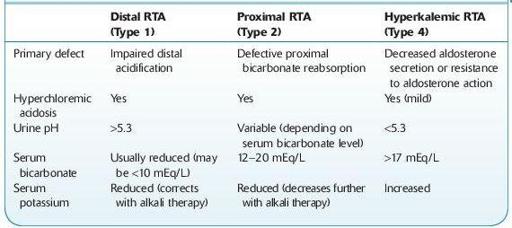Wallach's Interpretation of Diagnostic Tests: Pathways to Arriving at a Clinical Diagnosis (548 page)
Authors: Mary A. Williamson Mt(ascp) Phd,L. Michael Snyder Md

BOOK: Wallach's Interpretation of Diagnostic Tests: Pathways to Arriving at a Clinical Diagnosis
12.35Mb size Format: txt, pdf, ePub
Most commonly due to increased excretion of light chains in multiple myeloma and other monoclonal gammopathies. Other causes of proximal RTA include drugs (e.g., carbonic anhydrase inhibitors, ifosfamide, aminoglycosides), heavy metals (e.g., lead, mercury), and vitamin D deficiency. Primary causes of proximal RTA can be idiopathic or familial (e.g., bicarbonate transfer mutations, tyrosinemia, galactosemia, Wilson disease, cystinosis, and carbonic anhydrase type 2 deficiency).
Laboratory Findings
Variable urine pH, depending on whether the patient is treated with alkali therapy or not (generally elevated with alkali therapy and appropriately 5.3 or less in untreated patients in whom filtered bicarbonate level is below the bicarbonate reabsorptive threshold).
Low serum bicarbonate concentration (12–20 mEq/L) with hyperchloremic acidosis. Intravenous (IV) infusion of sodium bicarbonate (0.5–1.0 mEq/kg/ hour) causes an increase in serum bicarbonate concentration toward normal (18–20 mEq/L) and a rapid increase in urine pH (>7.5) and fractional excretion of bicarbonate (>15–20%).
Combined or Mixed RTA (Type 3)
Mixed RTA is most often applied to a rare autosomal recessive syndrome that results from carbonic anhydrase II deficiency and has features of both proximal and distal RTA.
Hyperkalemic RTA (Type 4)
This type results from either aldosterone deficiency (e.g., primary adrenal insufficiency, ACE inhibitors, severe illness, inherited disorders) or tubular resistance to aldosterone action (e.g., pseudohypoaldosteronism).
Characterized by mild hyperchloremic metabolic acidosis and hyperkalemia.
Major laboratory findings: serum bicarbonate concentration typically >17 mEq/L, urine pH <5.3, and increased plasma potassium.
See Table
12-6
.
TABLE 12–6. Characteristics of Different Types of Renal Tubular Acidosis

Suggested Reading
Kelepouris E, Agus ZS. Overview of renal tubular acidosis. In: Basow DS (ed).
UpToDate
. Waltham, MA: UpToDate; 2013.
RENAL VEIN THROMBOSIS
Definition
Other books
The Aftermath by Jen Alexander
Advancing ((Advance Industries #2)) by K A Duggsy
Mi ex novia by Fabio Fusaro
Who Do You Trust? by Melissa James
Forget About Midnight by Trina M. Lee
A Fine Line by William G. Tapply
Devotion by Dani Shapiro
Hannah and the Highlander by Sabrina York
The Sisters Club by Megan McDonald
